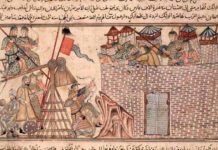North Korea is an enigma to Western observers, but the stories of its national flowers offer a small insight into the country’s idiosyncrasies.
The Democratic People’s Republic of Korea (the DPRK – North Korea) of the 1960s was not the withdrawn, impoverished state we know today. Having rebuilt its industry from the Korean War with assistance from Moscow and Beijing, it was just starting to pursue its Juche policy of radical self-reliance, and it would not be until the 70s that Kim Il-sung’s personality cult required fervent observation. Realizing strong economic growth, the country had international ambitions and was seeking to establish itself as an exemplary Communist state.
Kimilsungia, “Flower of Loyalty”
On a diplomatic visit to Indonesia in 1965, Kim was presented with a recently cultivated orchid by President Sukarno, who offered to name the flower after the Korean leader. The official story is that Kim modestly declined the honor, and Sukarno (or, in some tellings, the North Korean people) had to insist he accept it. At any rate, the orchid was christened Kimilsungia (Kimilsonghwa), and became a symbol of the party regime and the esteem it was held in by the international community – a slight embellishment.
Unfortunately, Kimilsungia is not suited to the temperate climate of the Korean peninsula and its cultivation required careful tending in greenhouses. For a decade it was not widely grown. But in 1975 North Korean botanists succeeded in getting the orchid to bloom in April, in time for Kim’s birthday celebrations, and its popularity took off. A greenhouse was constructed in Pyongyang exclusively for its cultivation, and several others appeared throughout the country. So while Siebold’s Magnolia is the official floral emblem of the DPRK (the magnolia tree representing strength and its flowers beauty), Kimilsungia was dubbed the “loyalty flower”, and its cultivation a civic duty.
The Propaganda of Succession
After Kim Jong-il was established as Il-sung’s successor, it eventually became necessary to extend the personality cult to both men and give Jong-il his own flower. Cultivated by Japanese botanist Kamo Motoderu, and presented to Kim Jong-il on his 46th birthday, Kimjongilia was the product of forty years work with a South American begonia. Also tropical, the begonia had to be grown in greenhouses in winter to be available for Jong-il’s February birthday celebrations. The flower was so important to Jong-il’s image it had a song composed in its honor:
“The red flowers that are blossoming over our land
Are like our hearts: full of love for the leader.
Our hearts follow the young buds of Kimjongilia;
Oh, the flower of our loyalty!”
Today Kimilsungia and Kimjongilia are employed lavishly for important celebrations, where tens of thousands of the flowers are put on display. The central press runs stories about patriotic citizens who diligently attend to them, and inflate accounts of their international prestige. Initially a curiosity, their management is now a civic duty and source of pride for North Koreans. Even during the famines of the 1990s the begonias and orchids were carefully attended to. The story of their rise to prominence offers a stark contrast with the dwindling fortunes of the DPRK, as the Cold War ran its course and left the country a curious relic.
Sources:
- Cumings, Bruce. Korea’s Place in the Sun: A Modern History. New York and London: W.W. Norton & Company, 2005.
- Lankov, Andrei. North of the DMZ: Essays on Daily Life in Korea. Jefferson, North Carolina and London: McFarland & Company, 2007.








